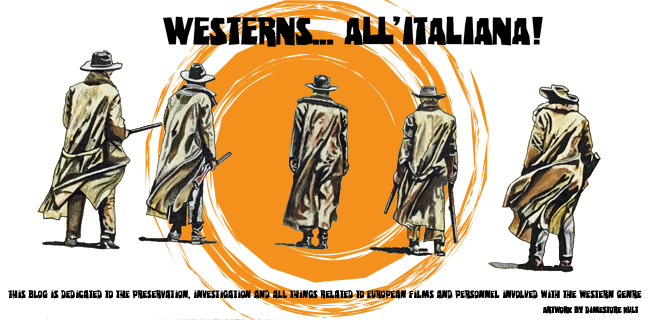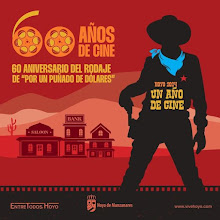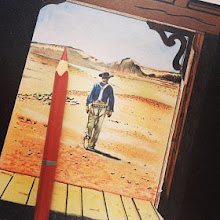Wild East, USA. Format: NTSC Region 0.
A Placed Called Glory Directed by Sheldon Reynolds. 1965. 93 min. Widescreen (2.35:1 anamorphic).
Two professional gunfighters, Clint Brenner (Lex Barker) and a mysterious Frenchman (Pierre Brice), become friends following a chance meeting on the open trail. The pair is oblivious to the fact that they are scheduled to go head to head in a "gunfight to the death" competition that is the highlight of Glory City's Founder's Day celebrations. As it is, the duo has more pressing problems: when they stop off at Powder City they become embroiled in a range war that is threatening to erupt between Seth Grande (Jorge Rigaud) and Jack Villaine (Gerard Tichy). The leader of a gang of violent thugs, Villaine is acting on behalf of local cattle barons who are angry that Grande is allowing homesteaders to settle on his land. The fact that Grande's daughter Jade (Marianne Koch) is romantically involved with Villaine, albeit under sufferance, doesn't help matters. Villaine assumes that Brenner and the Frenchman are working for Grande and he orders his gang to dispose of the duo.
This West German/Spanish co-production is notable because it features the stars associated with the long-running Winnetou series - Lex Barker and Pierre Brice - cast somewhat against type: both men play sharp-shooting fast guns who make a living by entering gunfighter competitions that are effectively duels to the death. That said, both men are fairly likeable characters and they share a reasonably moral outlook on life, which results in them reluctantly siding with Grande when Villaine's bullying thugs start provoking trouble. Said thugs count genre favorites Aldo Sambrell and Antonio Molino Rojo among their number. Marianne Koch's Jade is a world-weary saloon owner and the unhappy state of her love-life is a little reminiscent of that of her Marisol character from A Fistful of Dollars. Also joining Koch, Sambrell and Rojo here is another Dollars star, Wolfgang Lukschy, who plays Jade's ever-observant barman. Euro cult favorites Victor Israel and Luis Barboo also provide interesting turns.
This is a fairly intimate show that follows the detailed interactions of just a handful of characters for much of its running time. It's also a fairly claustrophobic show too: key scenes unfold within the confines of hotel rooms or with their main players huddled around saloon tables or stood at saloon bars. An abundance of nighttime scenes, an extended game of poker and Villaine's gangsterish traits imbue the show with a film noirish vibe. As far as the action goes, a number of decently executed confrontations, fistfights and shootouts successfully serve to offset one or two overly-talky sequences. The film's finale - in which Brenner and the Frenchman unwittingly face each other in Glory City's gunfighter contest - is really interesting and well-staged. Reminiscent of Sam Peckinpah's observations on the dark side of human nature, the bloodlust displayed by the town's residents - young, old, male and female alike - is very disturbing. Angel Arteaga's spirited soundtrack score (which was arranged and conducted by Bruno Nicolai) is fairly average by genre standards but it gets the job done. Picture quality fluctuates a little here. At its best it's just short of very good but the quality dips a bit during a couple of scenes. The presentation's sound quality is good but it remains a tad muffled in spots.
Extras: an image gallery and a trailer.
The Road to Fort Alamo Directed by Mario Bava. 1964. 79 min. Widescreen (2.35:1 anamorphic).
Bud (Ken Clark) comes across a squad of massacred Union soldiers and discovers a cheque from the Wagon City Bank that promises to pay the army $150,000. He soon links up with Slim (Alberto Cevenini) who introduces him to Carson (Michel Lemoine) and his gang of cattle-rustlers. Posing as Union soldiers, the gang succeeds in cashing the cheque but a subsequent attack by Osage Indians results in the villains losing their civilian clothes. Carson takes off with the cash while a Union army convoy, that is escorting a party of officers’ wives to Fort Alamo, rescues Bud and Slim. The duo succeeds in passing themselves off as genuine soldiers but things get complicated when the convoy subsequently rescues Carson and suffers further attacks by the Osage Indians.
Horror maestro Mario Bava's first Western possibly has more in common with John Ford’s work than Sergio Leone’s but it remains an interesting effort. Filmed at roughly the same time as Leone's A Fistful of Dollars, The Road to Fort Alamo is one of those early Italian Westerns that were specifically designed to fool Italian audiences into thinking that they were paying to watch an American production. As such, the film draws upon the tried and tested but somewhat tired "warring Indians versus the US army" generic template: a template that was subsequently rarely used in later Spaghetti Westerns. However, Bava does a great job of making the overly familiar iconography - and the clichéd set pieces - borrowed from similarly themed US Westerns seem fresh and exciting. Former Peplum star Ken Clark does a reasonably good job of reinventing himself as a brawny gunman but Euro cult favorite Michel Lemoine steals the show with a suitably deranged performance.
The Road to Fort Alamo may be a low budget feature but Bava and cinematographer Ubaldo Terzano's sure handed visuals make this a colorful and relatively well-constructed show. There are a multitude of good-looking, stylish and expertly composed shots present here that make good use of Bava's trademark color gels and lighting effects. Bava fans will love the highly stylized studio sets that the director constructed and employed for the show's night time exterior sequences. And while the film is a B movie through and through it does possess bags of (sometimes quite naive) charm. The show successfully serves up a string of (way too obvious and slightly hokey but still remarkably fun and intriguing) narrative hooks that ensure that the viewer is held in a near-perpetual state of suspense. Piero Umiliani's lively soundtrack score is a tad overdramatic at times and parts of it appear to possess a slightly incongruous Jazz influence. However, the rousing cues that the composer produced for the show's action-packed finale work a treat. Picture quality here is generally very good, as is the presentation's sound quality.
Extras: an image gallery and a trailer.
© 2011 Copyright Lee Broughton.
A more detailed review of The Road to Fort Alamo can be found here: http://www.dvdtalk.com/dvdsavant/s2895lee.html











No comments:
Post a Comment